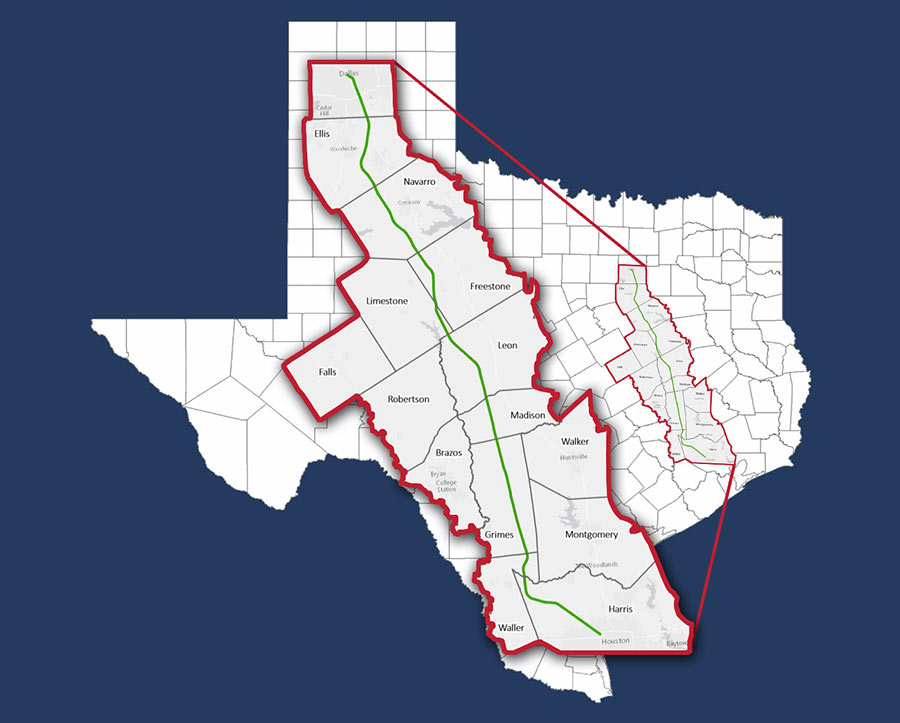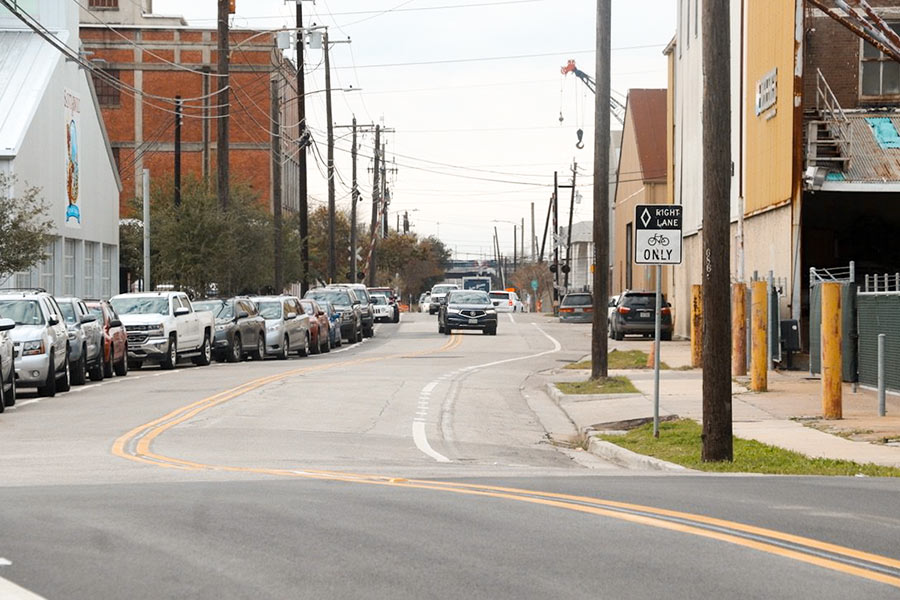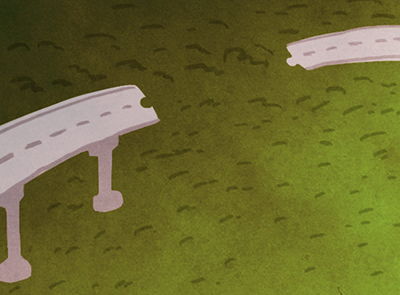WHERE THE SIDEWALKS END “On Airline Drive, for example, up to 40,000 people arrive every weekend to visit flea markets that line both sides of the road. The neighborhood’s management district is gearing up to spend $2.9 million on pedestrian improvements, including two new, signalized crosswalks on Airline, as well as sidewalks on nearby streets that are heavily used by local residents. . . . [Harris County] has a policy of not installing sidewalks when it builds a new road, unless a group or city provides the extra money. ‘It’s an expense that doesn’t have to do with transportation,’ said Mark Seegers, a spokesman for Harris County Commissioner Sylvia Garcia. ‘The county does not do sidewalks; it’s not what gets cars from point A to point B.’ . . . In the eight-county region that includes Houston, an average of 100 pedestrians died every year between 2003 and 2008, and an average of 1,175 were injured, mostly within Harris County, according to statistics compiled by the Texas Department of Transportation. More than half of all pedestrian deaths occur on [high-capacity, high-speed roads called ‘arterials’], often as people are trying to cross to reach retail shops or bus stops.” [Houston Chronicle]




Mark Seegers is right! Sidewalks have nothing to do with transportation. I know when I drive to a place, after I park, I simply teleport into the building that I wish to enter. My feet never touch a sidewalk.
The study is flawed.
.
The formula they use to rank cities is a ratio of the number of pedestrian deaths per capita divided by the percentage of commuters that reported walking to work during the last Census. From one of their own footnotes: “The Census Journey-to-Work data is limited in that it provides information only on the mode people choose most often and for the greatest distance to travel to and from work.”
.
That means that someone who walks a mile to a bus stop, takes a bus five miles to work, and then walks another mile to work probably spends most of their time on foot, yet doesn’t get counted in the index’s denominator.
.
The index puts spread-out cities at a remarkable disadvantage, just by virtue of regional land use patterns and densities. And the effect of their data validity problem is to hurt any spread-out city that has an extensive and successful bus system…like ours.
.
Clearly there are numerous examples of where sidewalks are wanting in the Houston metropolitan area, we are by no means a utopia of pedestrian infrastructure. Nevertheless, this data fails to provide us with an accurate or valid gauge of our performance as compared with rival cities.
Everything you wanted to know about Houston’s attitude to non-automotive transportation in one concise soundbite -“Sidewalks are an expense that doesn’t have to do with transportation”
A statement like â€Sidewalks are an expense that doesn’t have to do with transportation†really demonstrates why non-car travel is so difficult and even dangerous in Houston: it’s due to stupidity.
Wow, what a fool. I can attest that walking in my neighborhood (Shady Acres) sucks and is dangerous… no sidewalks AND ditches! We brave it, but I can’t imagine having a kid and letting them dodge traffic to say, get to the park. I’m hopeful that one day Houston will figure it out, just hope it’s soon!
The study may or not be flawed, but anyone who has ever lived in/or visited another, comparably large city already knew that Houston is an unsafe and difficult city to walk in.
Whether the latest list showing how Houston sucks is right or wrong; it’s really irrelevant considering that the ethereal “creative class” who runs the Media from ‘forward-thinking, New Urban cities’ such as New York and San Francisco, has irrefutably determined that Houston is a dump.
Rather, the real issue I think we ought to concern ourselves with is how to most quickly replace elected officials whose representatives make asinine statements–statements which by the way–lend themselves easily to the continued propagation of tired themes and pejorative (if not unfounded) characterizations of the City of Houston by said media establishment.
Whether the study is flawed or not, we should be ranked dead last regardless, purely as a result of the asinine comment made by Mark Seegers.
The last line of the Swamplot entry says that more than half of all deaths occur when pedestrians try to cross busy arterial streets. How will sidewalks help with that? If by “sidewalks” we mean “crosswalks and pedestrian signals,” well, OK. I’d be willing to bet that the vast majority of those deaths are attributable to inattention on the part of drivers or pedestrians or both.
Actually it says “More than half of all pedestrian deaths occur on [high-capacity, high-speed roads called ‘arterials’], often as people are trying to cross to reach retail shops or bus stops.” The operative word being “often.” The article doesn’t tell us how many are killed trying to cross the street, and how many of those were crossing without a light or at a point where there is no crosswalk.
There are too many high-speed arterials, especially outside the Loop, with no sidewalks. I was taking the bus to work for about a month earlier this year (I work in an office on the North beltway). There are bus stops there but no sidewalks. Speeds on the feeder road tend to be 45 to 50 mph. There are few pedestrians (for obvious reasons) but there are some; bus commuters like me, kids walking to school every day, etc. They will walk on muddy paths to avoid walking in the street. And bus riders with wheelchairs or strollers are simply SOL. I liked riding the bus, but not the sidewalk-free walk at the end of the ride.
Houston didn’t fare so well in T4’s “Pedestrian Death Index” either (http://abcnews.go.com/US/wireStory?id=9034187). I think the attitude of our county officials makes it easy to see how that might happen.
I agree that in the suburbs here, the pedestrian infrastructure is terrible. But frankly that is the case in most recently developed suburbs and exurbs around this country.
Houston’s pedestrian infrastructure is bad even in places where walking could be a feasible alternative. Sidewalks are broken or non-existent, crosswalks are slim to scarce, streets are too wide with traffic traveling at high speeds and blocks are too long. Even in Midtown the situation is pretty pathetic given Houston is the 4th largest city in the US.
World Class.
You can see the attitude here toward sidewalks even in pedestrian friendly areas – I’m amazed how many people will park in their driveways blocking sidewalks here in the Heights. Must be a lot of fun for someone in a wheelchair (like, say, lots of people in the senior citizen housing at 20th & Heights…) or otherwise mobility-impaired. Oh well, who cares about them…
It’s particularly amazing to see when there’s a ton of room in front of the car in the driveway, and tons of street parking right in front of the house.
The is the first place I’ve lived where your car would not be quickly towed away for doing that in any central city neighborhood.
The is the first place I’ve lived where your car would not be quickly towed away for doing that in any central city neighborhood.
_______________
And try to get HPD to even go stick a ticket under the windshield wiper. It is particularly bad in Montrose with all the townhouses that the homeowners obviously use the garage for an extra room.
And try to get Sue Lovell’s office to return a phone call about it. That was one of many reasons why I didn’t vote for her.
I wonder how many of our pedestrian deaths are idiots trying to cross the North Freeway on foot? Seems like there’s a news story in the Chron just about every couple of months reporting on yet another loser of the Freeway Frogger game.
“The last line of the Swamplot entry says that more than half of all deaths occur when pedestrians try to cross busy arterial streets.”
The study says that arterials are a factor in more than half of the pedestrian deaths. That includes walking along or crossing an arterial. They allow cars to travel at high rates of speed, and they are not built for pedestrians, so they are “dangerous by design.”
Some of these areas are in the city – I wonder if we have a sidewalk ordinance although most likely it is only used when someone tries to build a hirise on Bissonnet. I probably shouldn’t have mentioned that. Annise Parker will have someone check.
It is amazing how sidewalks don’t seem to be a priority in the city. And it is just as much an “urban” problem as it is a “suburban” one. I suspect the homeowner is responsible. I’ve never checked. But if so, commercial property owners would be responsible as well. And the city should force the issue. Maybe Gene Locke will. Annise Parker will be too busy running interference for her buddies at V&E as they continue to try to “Stop Ashby” and of course the money the city could be spent for sidewalks, regardless of who should or should not pay for them, is better spent defending spoiled brats and their law firm.
I’m not sure why the city isn’t responsible for sidewalks, just as they are responsible for the streets. It seems to me to be part of the overall transportation infrastructure that should be funded by public funds.
Given the amount of open space here and the wide setbacks of most buildings, even inside the loop, there is plenty of space for pretty generous sidewalks and bike paths along many streets. To me it seems like more of a political problem (i.e. lack of a plan, vision, etc.) and an entrenched way of thinking that seems to rule here. “That’s the way it has always be done.” The comments of Mr. Seegers exemplify this mindset. It’s time to grow up Houston; this isn’t some little honky-tonk, two-bit town anymore.
Speaking of…
Deputies: Truck hits cyclist, drags him for mile in East Harris
http://www.chron.com/disp/story.mpl/metropolitan/6716932.html
What amazes me is all the new construction the past ten years or so in areas like Rice Military and the Heights that have no sidewalks since supposedly you cannot get a building permit unless your plan includes a sidewalk. Maybe they just put them on the plans and then cut costs by cutting the sidewalks? I was told it applies to commercial property as well. So, well, where’s the sidewalks?
Sidewalks don’t have anything to do with transporation?
Thanks for making me realize why Houston is such a hell-hole.